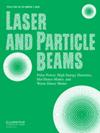Selective amplification of the chirped attosecond pulses produced from relativistic electron mirrors
IF 1.9
4区 物理与天体物理
Q4 PHYSICS, APPLIED
引用次数: 0
Abstract
In this paper, the generation of relativistic electron mirrors (REMs) and the reflection of an ultra-short laser off this mirrors are discussed, applying two-dimensional particle-in-cell (2D-PIC) simulations. REMs with ultra-high acceleration and expanding velocity can be produced from a solid nanofoil illuminated normally by an ultra-intense femtosecond laser pulse with a sharp rising edge. Chirped attosecond pulse can be produced through the reflection of a counter-propagating probe laser off the accelerating REM. In the electron moving frame, the plasma frequency of the REM keeps decreasing due to its rapidly expanding. The laser frequency, on the contrary, keeps increasing due to the acceleration of REM and the relativistic Doppler shift from the lab frame to the electron moving frame. Within an ultra-short time interval, the two frequencies will be equal in the electron moving frame, which leads the resonance between laser and REM. The reflected radiation near this interval and the corresponding spectra will be amplified due to the resonance. Through adjusting the arriving time of the probe laser, certain part of the reflected field could be selectively amplified or depressed, leading to the selectively adjusting of the corresponding spectra.相对论性电子镜产生的啁啾阿秒脉冲的选择性放大
本文应用二维粒子池(2D-PIC)模拟,讨论了相对论性电子镜(REMs)的产生和超短激光在电子镜上的反射。在具有明显上升沿的超强飞秒激光脉冲的正常照射下,固体纳米箔可以产生具有超高加速度和膨胀速度的REMs。通过反向传播的探测激光反射加速的REM,可以产生啁啾阿秒脉冲,在电子运动框架中,REM的等离子体频率由于快速膨胀而不断降低。相反,由于REM的加速和从实验室框架到电子运动框架的相对论多普勒频移,激光频率不断增加。在一个超短的时间间隔内,两个频率在电子运动框架内相等,导致激光和REM之间发生共振,在这个间隔附近的反射辐射和相应的光谱会因为共振而被放大。通过调整探测激光到达的时间,可以选择性地放大或抑制部分反射场,从而选择性地调整相应的光谱。
本文章由计算机程序翻译,如有差异,请以英文原文为准。
求助全文
约1分钟内获得全文
求助全文
来源期刊

Laser and Particle Beams
PHYSICS, APPLIED-
CiteScore
1.90
自引率
11.10%
发文量
25
审稿时长
1 months
期刊介绍:
Laser and Particle Beams is an international journal which deals with basic physics issues of intense laser and particle beams, and the interaction of these beams with matter. Research on pulse power technology associated with beam generation is also of strong interest. Subjects covered include the physics of high energy densities; non-LTE phenomena; hot dense matter and related atomic, plasma and hydrodynamic physics and astrophysics; intense sources of coherent radiation; high current particle accelerators; beam-wave interaction; and pulsed power technology.
 求助内容:
求助内容: 应助结果提醒方式:
应助结果提醒方式:


